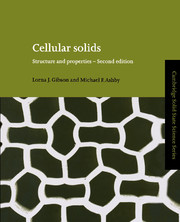Book contents
- Frontmatter
- Contents
- Preface to the second edition
- Preface to the first edition
- Units and conversion tables
- Chapter 1 Introduction
- Chapter 2 The structure of cellular solids
- Chapter 3 Material properties
- Chapter 4 The mechanics of honeycombs
- Chapter 5 The mechanics of foams: basic results
- Chapter 6 The mechanics of foams: refinements
- Chapter 7 Thermal, electrical and acoustic properties of foams
- Chapter 8 Energy absorption in cellular materials
- Chapter 9 The design of sandwich panels with foam cores
- Chapter 10 Wood
- Chapter 11 Cancellous bone
- Chapter 12 Cork
- Chapter 13 Sources, suppliers and property data
- Appendix: The linear-elasticity of anisotropic cellular solids
- Index
- References
Chapter 5 - The mechanics of foams: basic results
Published online by Cambridge University Press: 05 August 2014
- Frontmatter
- Contents
- Preface to the second edition
- Preface to the first edition
- Units and conversion tables
- Chapter 1 Introduction
- Chapter 2 The structure of cellular solids
- Chapter 3 Material properties
- Chapter 4 The mechanics of honeycombs
- Chapter 5 The mechanics of foams: basic results
- Chapter 6 The mechanics of foams: refinements
- Chapter 7 Thermal, electrical and acoustic properties of foams
- Chapter 8 Energy absorption in cellular materials
- Chapter 9 The design of sandwich panels with foam cores
- Chapter 10 Wood
- Chapter 11 Cancellous bone
- Chapter 12 Cork
- Chapter 13 Sources, suppliers and property data
- Appendix: The linear-elasticity of anisotropic cellular solids
- Index
- References
Summary
Introduction and synopsis
Almost any solid can be foamed. Techniques now exist for making three-dimensional cellular solids out of polymers, metals, ceramics and even glasses. Manmade foams, manufactured on a large scale, are used for absorbing the energy of impacts (in packaging and crash protection) and in lightweight structures (in the cores of sandwich panels, for instance); their efficient use requires a detailed understanding of their mechanical behaviour. Even when the primary use is not mechanical – when the foam is used for thermal insulation, or flotation, or as a filter, for example – the strength and fracture behaviour are still important. Nature, too, uses cellular materials on a large scale. Often the primary function is mechanical, as with wood (to support the tree) or cancellous bone (to give the animal a light, stiff, frame). In other cases it may not be: the shape of the cells in leaf and stalk, or in cork and sponge, may be dictated by the need to optimize fluid transport or thermal insulation or surface area, but even here the mechanical properties are important because the cells still support the structure. And there is the consuming subject of food. Bread – The Staff of Life – and many other starch-based foods are foams. Foaming with yeast or CO2 gives the tough, leathery starch a crisp crunchiness which is attractive to bite on and chew (mechanical operations); but it also makes transporting the product more difficult because its crushing strength is reduced.
- Type
- Chapter
- Information
- Cellular SolidsStructure and Properties, pp. 175 - 234Publisher: Cambridge University PressPrint publication year: 1997
References
- 62
- Cited by



